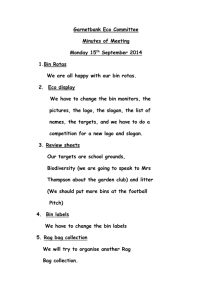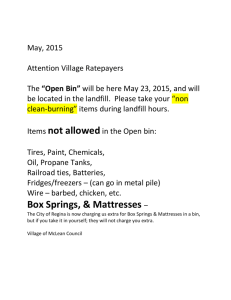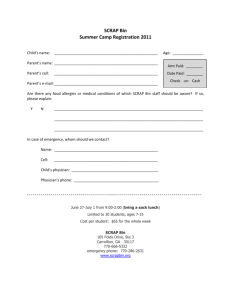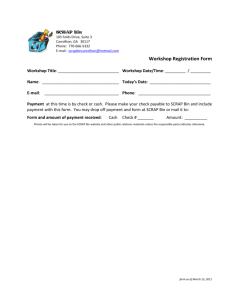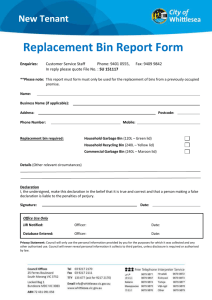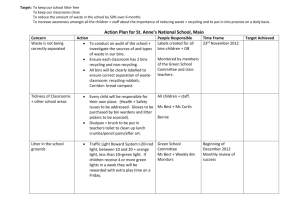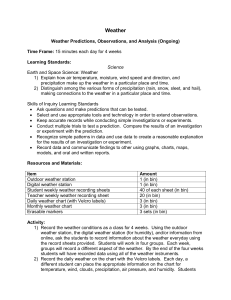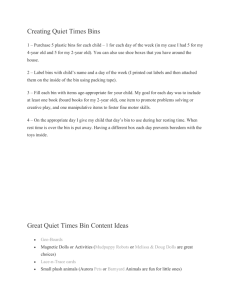Investigating Physical and Chemical Changes
advertisement
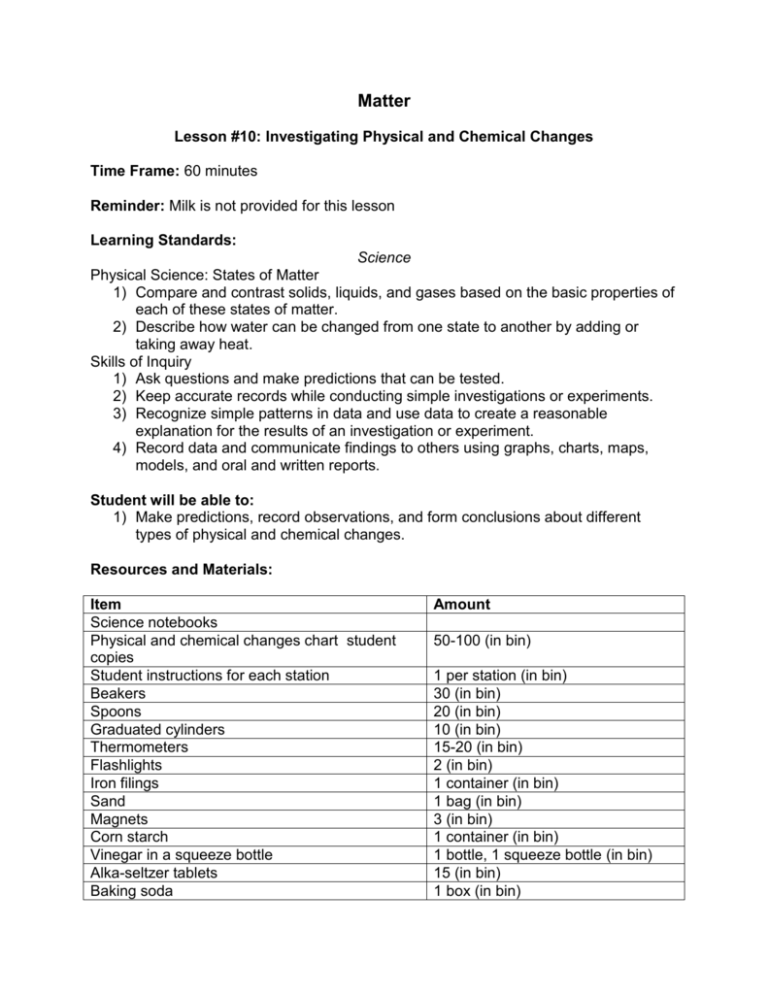
Matter Lesson #10: Investigating Physical and Chemical Changes Time Frame: 60 minutes Reminder: Milk is not provided for this lesson Learning Standards: Science Physical Science: States of Matter 1) Compare and contrast solids, liquids, and gases based on the basic properties of each of these states of matter. 2) Describe how water can be changed from one state to another by adding or taking away heat. Skills of Inquiry 1) Ask questions and make predictions that can be tested. 2) Keep accurate records while conducting simple investigations or experiments. 3) Recognize simple patterns in data and use data to create a reasonable explanation for the results of an investigation or experiment. 4) Record data and communicate findings to others using graphs, charts, maps, models, and oral and written reports. Student will be able to: 1) Make predictions, record observations, and form conclusions about different types of physical and chemical changes. Resources and Materials: Item Science notebooks Physical and chemical changes chart student copies Student instructions for each station Beakers Spoons Graduated cylinders Thermometers Flashlights Iron filings Sand Magnets Corn starch Vinegar in a squeeze bottle Alka-seltzer tablets Baking soda Amount 50-100 (in bin) 1 per station (in bin) 30 (in bin) 20 (in bin) 10 (in bin) 15-20 (in bin) 2 (in bin) 1 container (in bin) 1 bag (in bin) 3 (in bin) 1 container (in bin) 1 bottle, 1 squeeze bottle (in bin) 15 (in bin) 1 box (in bin) Lemon juice Glass plate Alcohol Sugar Bubbles Metal pan Steel wool Aluminum foil Salt Dull pennies Paper towels (not provided) Water (not provided) Milk (not provided) 5-6 bottles (in bin) 1 (in bin) 2 bottles (in bin) 1 container (in bin) 1-2 bottles (in bin) 1 (in bin) 1 bag (in bin) 1 box (in bin) 1 container (in bin) 20-30 (in bin) (in classroom) (in classroom) Focus Activity: Ask students to explain the differences between physical and chemical changes in their science notebooks. They can use their definition note cards from the last lesson as necessary. Discuss the differences as a class. Introduction: Talk about physical and chemical changes. Are physical changes reversible? Are chemical changes reversible? How can you tell that a chemical change has occurred? (Heat, cold, light, color, gas or solid production) Tell the students that they will observe and describe different types of changes in class today and classify them as either physical or chemical changes. Activity: 1) Pass out a copy of the physical and chemical changes chart to each student. Allow the students to work individually or in pairs. Set up the different stations around the room (with the materials and instructions) before class using the instructions provided below. Instruct students to follow the instructions at each station, record their observations and results, and explain if the change is a physical or chemical change. Assist students individually as necessary as they go to the different stations around the room. 2) Physical and Chemical Changes Stations: a. Materials: Iron filings, sand, spoons, beaker, magnet Students will mix the sand and iron filings and then use the magnet to separate the mixture (Physical change) b. Materials: Corn starch, spoon, beakers with water, flashlight Students will mix some corn starch into the water, stir well, and use the flashlight to observe the mixture (Physical change, suspension) c. Materials: Milk in beakers, vinegar in a squeeze bottle, spoon Students will mix the milk and vinegar and stir, observing what forms (Chemical change, solid forms) d. Materials: Alka-seltzer tablet, beakers with water Students will add a half (or quarter) of an Alka-seltzer table to water and observe (Chemical change, gas forms) e. Materials: Baking soda, 25 mL of lemon juice in beakers, spoon, thermometer Students will mix the baking soda and lemon juice and then record the temperate with a thermometer every minute (Chemical change, temperature drops) f. Materials: Alcohol, glass plate Students will pour a small amount of alcohol on a plate and observe (Physical change, evaporation) g. Materials: Sugar, spoon, beakers with water, flashlight Students will mix some sugar into the water, stir well, and use the flashlight to observe the mixture (Physical change, solution) h. Materials: Bubbles and a metal pan Students will blow bubbles onto a metal pan and observe (Physical change) i. Materials: Vinegar in a beaker, steel wool, thermometer, beakers, aluminum foil Students will soak some steel wool in vinegar, wring out the steel wool, wrap it around a thermometer, place it in a beaker, cover the beaker with aluminum foil, and record the temperature every minute (Chemical change, temperature rises, color changes) j. Materials: Vinegar and salt solution in beakers (60 ml vinegar mixed with 1 spoon of salt), pennies (dull), paper towels Students will hold pennies in the solution and observe the results (Chemical change, color changes) 3) Ask the students to share their results and conclusions with the class. Discuss each station and ask if it demonstrated a chemical or a physical change. Get different groups or individuals to share their ideas with the class and discuss any differences in opinion. Reinforce the concepts of physical change and chemical change through this discussion. Closure: Review the major concepts of this unit with the class. What is matter? What are three states of matter? How is the energy of each state different? Explain how water changes states. What type of change is this? What other types of changes can happen to matter? Assessment: Science notebook responses, physical and chemical changes chart including observations and conclusions, participation in class discussions Physical and Chemical Changes Station Observations Station #1 What happens? Station #2 Station #3 Station #4 Station #5 Conclusion: Please circle and explain. Physical Chemical Physical Chemical Physical Chemical Physical Chemical Physical Chemical Solution or suspension? Explain. What happens? What happens? Temperature: Start: ______ 1 minute: ______ 2 minutes: ______ 3 minutes: ______ 4 minutes: ______ 5 minutes: ______ What happens? Station #6 Station #7 Station #8 Station #9 What happens? Physical Chemical Physical Chemical Physical Chemical Physical Chemical Physical Chemical Solution or suspension? Explain. What happens? Temperature What happens? Start: ______ 1 minute: ______ 2 minutes: ______ 3 minutes: ______ 4 minutes: ______ 5 minutes: ______ Station #10 What happens?

